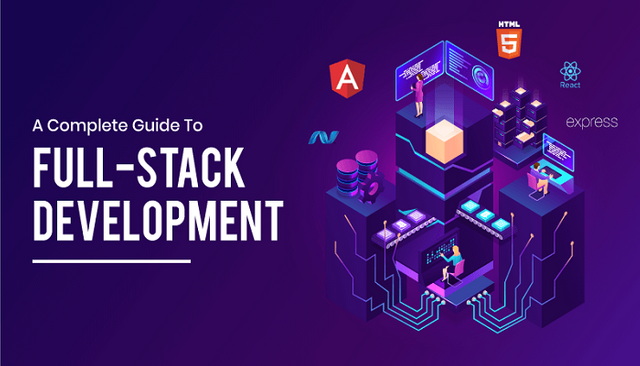What is Full Stack Development, Definition?
Full-stack development refers to the development of both front-end and back-end portions of an application. This web development process involves all three-layer- The presentation layer (front end part that deals with the user interface), Business Logic Layer (back end part that deals with data validation), and the Database Layer. It takes care of all the steps from the conception of an idea to the actual finished product.
Having a specialist work on each of the different subsystems of the web development process proves quite complex and expensive. Companies are demanding full-stack developers who are proficient in working across multiple stacks.

What is a full-stack developer?
A Full-Stack Web Developer is a web developer or engineer who works on both the front-end and back-end of a website or application — meaning they can tackle projects that involve databases, building user-facing websites, or even work with clients during the planning phase of projects. Being a Full-Stack Developer doesn’t mean that you have necessarily mastered everything required to work with the front-end or back-end, but it means that you are able to work on both sides and understand what is going on when building an application.
In fact, “full-stack” refers to the collection of a series of technologies needed to complete a project. “Stack” refers to a collection of sub-modules. These software sub-modules or components combined together to achieve the established function while without the need for other modules.
Technology related to full-stack development:
There are some essential technologies that you must learn in order to call yourself a full-stack developer. Here is a quick guide to what technologies you must learn.
HTML and CSS-
To begin your career in web development you must have the fundamental knowledge of HTML and CSS. They are the basic building blocks of the web that enable you to add content and styles to your web pages. So start your journey of becoming a full-stack developer by gaining a sound understanding of these front-end concepts.
JavaScript-
The fact that JavaScript can be used both in front-end and back-end development makes it very popular. It is one of the hottest technologies in the market where continuous innovations take place. With new tools and frameworks getting released every year, one needs a piece of sound knowledge in this area. Knowledge of JS frameworks like AngularJS and ReactJS would help one to write long codes with ease. A solid understanding of jQuery would be an added advantage.
Backend Programming Languages–
After gaining a strong foothold in the front-end arena next comes backend languages like Ruby, Python, PHP, etc. which handle application logic, user authentication, and data operations. Start with a language that is easier to learn. Whatever language you choose, just make sure you are thorough with its nuances. You may learn Node.JS which is based on JavaScript that you would have already learned before reaching this point.
Database & Web Storage-
In order to design and develop dynamic websites, one should surely know how database-driven websites store and access data. Learn the benefits of relational database management systems like SQL. Understand how to connect a backend language with a database. Gain knowledge about web storage so that you know how to store cookies, sessions, and cached data in the browser.
HTTP and REST-
You must gain insights into HTTP- that is the protocol required to facilitate communication between the client and server. You must also know how REST is important to the HTTP protocol and web applications. Knowledge of Chrome DevOps Tools and SSL certificates would be advantageous.
Read more: The Fundamentals of Front End and Back End Development
Additional skills set to adopt as full-stack developers are as follows.
Application Architecture-
Developing complex applications would require a deep knowledge of how the code should be structured, how the data needs to be structured in the database, how to separate files, where to perform computational tasks, and where to host large media files. So a full stack web developer surely needs a deep knowledge of web application architecture.
Version control system-
A full-stack web developer needs to be well versed with a version control system. An understanding of GIT will help you keep track of any changes that you make to the code base.
Acquiring expertise in so many technologies and becoming an expert in all the layers of web development may seem like a daunting task in the beginning. It’ll be hard work learning all of this, but it’s rewarding in the end and Full-Stack Development is fun!
https://www.charterglobal.com/understanding-full-stack-development/
This content appears to be plagiarised from -
https://sagaratechnology.medium.com/what-does-it-mean-by-full-stack-development-d07b3f5aa5c3
If you have not already done so, you should head to the newcomers community and complete the newcomer achievement programme. Not only will you earn money through upvotes, you will learn about content etiquette;
You are currently in Stage 1 of our 4 Stage Process:
👉 Stage 1 - 1st Warning - Pointing offenders towards Achievement 3 and highlighting this process. All plagiarised posts currently pending rewards will be flagged and downvoted to $0 rewards.
Stage 2 - A Final Warning - Another request to stop and that plagiarism will not be tolerated. Downvotes amounting to 20% of total pending rewards according to steemworld.
Stage 3 - A stronger message - Downvotes amounting to 50% of pending rewards.
Stage 4 - The strongest message possible - Downvotes amounting to 100% of pending rewards.
Plagiarists will bypass stage 1 if translated from another language.
Downvoting a post can decrease pending rewards and make it less visible. Common reasons:
Submit